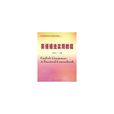圖書信息
正文語種: 簡體中文, 英語
開本: 16
ISBN: 9787811371932
條形碼: 9787811371932
尺寸: 22.9 x 18.3 x 1 cm
重量: 299 g
作者簡介
陳新仁,學歷:博士。畢業時間/畢業學校:1999.7/廣東外語外貿大學。職稱職務:教授,博士生導師。研究方向:普通語言學;語用學;外語教學法;英語修辭學。獲獎及榮譽稱號:1998年被評為江蘇省優秀中青年骨幹教師。社會兼職:國際語用學會(IPrA)、國際套用語言學協會(IALA)、美國語言學學會(LSA)、江蘇省修辭學會(JRS)會員,中國語用學學會(CPrA)副會長。
內容簡介
《英語語法實用教程》特色:1.注重語法講解過程中的語言環境,確保其真實性;注重語法信息量的充足性以及信息內容的可理解性和趣味性。2.打造全新的語法講解體系,以傳統語法體系為藍本,從概念出發,舉例充分。又從解決何時用、怎么用的問題出發,從學生組句需要出發,講解句子各個組成部分,同時考慮到交際中表達簡潔和強調的需要,講解相關語法選擇。超越語法知識本身,培養語法能力。3.注重語法的交際價值,大幅度改變將語法作為抽象語言知識學習的做法。從交際角度,比較相似結構之間的差別。區分常規結構與修辭結構。4.突出語法的文體、體裁特徵;很多語料取樣於現實生活,豐富多樣。5.關注語法與辭彙作為交際手段之間的聯繫。6.以中國學生學習英語為出發點和歸屬,考慮到母語的積極和消極影響以及讀者學習語言的經驗,不講不是很需要講的內容,預測性地呈現中國學生可能出現的語法問題。7.採用研究性學習理念,設計大量討論性、探索性、發現式問題,啟發學生髮現英語語法規律,培養學生的研究思維和能力。努力改變傳統知識類教材的刻板方式,幫助教師克服一言堂的教學模式。
媒體評論
以往語法課多半“一言堂”,老師講,學生聽,氣氛沉悶。《英語語法實用教程》另闢蹊徑,以學生為中心,注重師生互動,融語法知識的講解和套用於課堂活動中,為我國英語語法教學改革提供了一個新的選擇。
——張月祥教授(上海外國語大學英語學院語法研究專家)
《英語語法實用教程》圖文並茂,體系新穎,不僅繼承了傳統英語語法的優點,而且吸收了現代語言學的最新成果;融枯燥的英語語法規則於真實多樣而生動的語篇之中,既增強了可讀性和實用性,又突顯了交際能力的培養;研究型練習設計富於啟發性,可以幫助讀者學習掌握語法知識,繼而提高讀者的英語表達能力。
——張克定教授(河南大學外國語學院博士生導師)
《英語語法實用教程》迥異於以灌輸為主的傳統語法教科書,其編寫融入了最新的教學理念和編者對語法教學的深刻理解,內容設計富有創意。本教程帶給學生的將不僅僅是語法知識和能力,更有全新的學習體驗和創新思維能力。
——張文忠教授(南開大學外國語學院博士生導師)
目錄
Unit 1 Preliminaries about Grammar
Pre-Class Reading/1
1.1 Language and its grammar/1
1.2 Grammatical knowledge/1
1.3 Grammatical competence/2
1.4 Learning English grammar/3
In-Class Activities/4
Post-Class Tasks/7
Project Work/7
Part One The Structure of English Sentences
Unit 2 Constructing English Sentences
Pre-Class Reading/13
2.1 Sentence components in English/13
2.2 Sentence patterns in English/14
2.3 Movements of sentence components/15
In-Class Activities/16
Post-Class Tasks/20
Project Work/22
Unit 3 Functional Taxonomy of English Sentences
Pre-Class Reading/23
3.1 Declarative sentences in English/23
3.2 Interrogative sentences in English/23
3.3 Imperative sentences in English/25
3.4 Exclamatory sentences in English/25
In-Class Activities/26
Post-Class Tasks/31
Project Work/33
Unit 4 Grammatical Markers in English Sentences
Pre-Class Reading/34
4.1 The plurality marker/34
4.2 The possessive case marker/35
4.3 The tense/aspect markers/36
4.4 Degree markers for adjectives/adverbs/37
In-Class Activities/38
Post-Class Tasks/41
Project Work/43
Part Two The Subject and the Object
Unit 5 The Subject
Pre-Class Reading/47
5.1 The form choices of the Subject/47
5.2 The meaning choices of the subject/48
5.3 The subject-predicate agreement in number/49
In-Class Activities/50
Post-Class Tasks/54
Project Work/58
Unit 6 The Object
Pre-Class Reading/59
6.1 Defining the object/59
6.2 The form choices of the object/60
6.3 The meaning choices of the object/61
In-Class Activities/62
Post-Class Tasks/64
Project Work/67
Unit 7 Determiners in Noun Phrases
Pre-Class Reading/68
7.1 Defining the notion of "determiner"/68
7.2 Types of determiners/69
7.3 The co-occurrence of determiners/70
In-Class Activities/71
Post-Class Tasks/76
Project Work/80
Unit 8 Attributives: Modifiers in Noun Phrases
Pre-Class Reading/81
8.1 The definition of the attributive/81
8.2 The form choices of the attributive/82
8.3 The relative clause/84
8.4 Ordering modifiers in noun phrases/87
In-Class Activities/88
Post-Class Tasks/92
Project Work/96
Part Three The Predicate and Related Grammatical Categories
Unit 9 The Terse and Aspect Systems
Pre-Class Reading/99
9.1 The predicate/99
9.2 The tense of the predicate/100
9.3 The aspect of the predicate/101
9.4 Present tenses/102
9.5 Past tenses/104
9.6 Future times/104
In-Class Activities/106
Post-Class Tasks/110
Project Work/115
Unit 10 The Mood System
Pre-Class Reading/117
10.1 Mood as a grammatical category/117
10.2 Form choices of the subjunctive mood/118
10.3 Function choices of the subjunctive mood/120
In-Class Activities/122
Post-Class Tasks/126
Project Work/130
Unit 11 The Modality System
Pre-Class Reading/131
11.1 Types of modal verbs/131
11.2 Categories of modality/132
11.3 Modality and politeness/132
In-Class Activities/133
Post-Class Tasks/138
Project Work/140
……
Part Four The Adverbial and the Complement
Unit 12 The Adverbial
Unit 13 The Complement
Part five Grammar and Text
Unit 14 Inversion
Unit 15 Ellipsis and Substitution
Unit 16 Cohesion in English Texts
Refefences 210
Glossary 213

